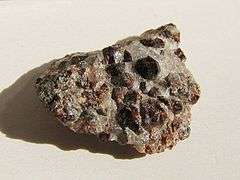Calderite
| calderite | |
|---|---|
|
| |
| General | |
| Category | Silicate mineral |
| Formula (repeating unit) | (Mn2+Ca)3(Fe3+Al)2(SiO4)3 |
| Strunz classification |
9.AD.25 (10 ed) 8/A.08–40 (8 ed) |
| Dana classification | 51.4.3a.6 |
| Crystal system | Cubic |
| Crystal class |
Hexoctahedral (m3m) H-M symbol: (4/m 3 2/m) |
| Unit cell | a = 11.819 Å; Z = 8 |
| Identification | |
| Color | brownish red to brownish yellow |
| Cleavage | None |
| Mohs scale hardness | 6.5-7.5 |
| Luster | Vitreous |
| Streak | white |
| Diaphaneity | transparent to translucent |
| Specific gravity | 3.756 |
| Optical properties | Isotropic |
| Refractive index | n = 1.872 |
| References | [1][2] |
Calderite is a mineral in the garnet group with the chemical formula (Mn2+, Ca)3(Fe3+, Al)2(SiO4)3.
It is dark reddish brown to dark yellowish in color and generally granular massive in form.[3]
It was named for geologist James Calder who worked on the geology of India. The name was first applied to a rock in manganese deposits in Katkamsandi, Hazaribagh district, Bihar and at Netra, Balaghat district, Madhya Pradesh, India. later transferred to its predominant mineral.[2][3] In 1909 it was described as a mineral from Otjosondu, Otjozondjupa Region, Namibia.[1]
See also
- James Calder; J. D. Herbert (1981). Geology of the Indian Sub-continent: Observations on Mineralogy, Cypsum, Mines and Mountain Formations (reprint ed.). Cosmo Publications. p. 218.
References
This article is issued from Wikipedia - version of the 11/26/2016. The text is available under the Creative Commons Attribution/Share Alike but additional terms may apply for the media files.
